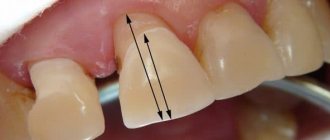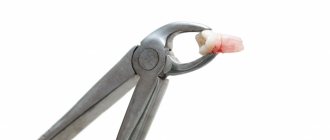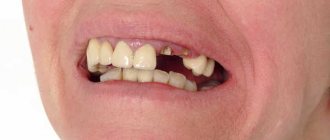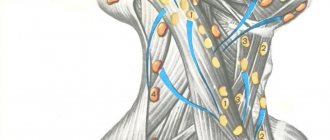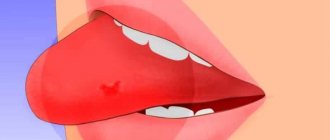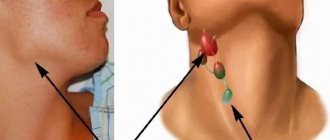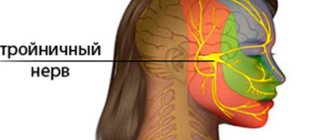44024
Although extraction in dentistry is considered a complex operation, the technique for performing it is very well developed, and adverse consequences are observed in isolated cases.
But sometimes it happens that during a complex tooth extraction, a small fragment remains in the socket. Then it is important not to let the condition worsen and to see a doctor before complications appear.
Causes
The circumstance when, after extraction of a problematic tooth, a small fragment of it remains in the gum (usually a fragment of the root), arises for a number of reasons.
Difficult case
Often, patients turn to a specialist in an extremely advanced and difficult to treat case, when the degree of visualization of such a unit during surgery is difficult.
The dentist can miss a small part in the hole only because of difficulties during manipulation. Often, a badly damaged tooth splits during extraction, and it has to be pulled out in separate parts. In such a situation, it is important to extract all the pieces, otherwise the person may face serious consequences.
When pulling out pieces of the destroyed unit onto a napkin, the doctor must make sure that no unnoticed parts remain in the hole. If there is any doubt about this, radiography is prescribed.
But even with strict adherence to the procedure technique, situations with incomplete extraction due to the complexity of the case are not uncommon.
Splitting of the root into many small fragments
This situation occurs with a complex fracture, often longitudinal, against the background of:
- severe inflammation (with phlegmon, cyst, periostitis, abscess, osteomyelitis);
- severe destruction of the crown, reaching the roots;
- incorrect position of the unit;
- strong root mobility.
Unnoticed by the dentist, the splinter does not allow the wound to heal completely and moves to the upper part of the hole, causing pain and discomfort from the low-grade inflammation that has begun in the oral cavity.
The danger also lies in the fact that other complications can join the inflammation, thereby worsening the person’s condition.
Large crown and root surface
More often than usual, pieces remain in the gum when a figure eight (wisdom tooth) is removed. Having a large root system and a massive body, the third molar is very difficult to extract even for an experienced doctor.
This tooth is most often removed because:
- growing in the wrong direction;
- has longer and more curved roots than other units;
- does not fully erupt;
- the roots fuse with the jaw bone.
Hard to reach location
Units located in the far part of the oral cavity are very difficult to visualize , and if problems with the anatomical structure of the oral cavity are added to this, the extraction may not be completed completely, and a tooth fragment may remain in the gum.
Crumpling of an adjacent tooth during extraction
If there are two badly damaged units nearby, then during the amputation of one of them, a fragment of the neighboring one may fall into its socket.
This can happen when an instrument accidentally presses on the crown of an adjacent tooth, when for a number of reasons it is not possible to completely capture the unit being pulled out.
How to remove tooth debris
Most often, patients ignore visiting the dentist because of the common fear of pain during extraction: the memories are still too fresh of how in the 90s, in many clinics, teeth were mercilessly pulled out without pain relief. Modern dentistry has good anesthetics that make the procedure painless. The most unpleasant sensations are an injection into the gums when frozen and a possible aching pain after the drug wears off.
There are several methods for removing residue. The choice of technology depends on where the tooth is located and the reason why the fragment appeared:
- Forceps. The doctor separates the circular ligament and soft tissue before applying forceps, tightly grasping the tooth pieces with his cheeks and removing them from the gums. Instruments may differ in shape and structure, depending on which teeth and on which jaw need to be removed. For example, straight forceps are used for incisors and canines, bayonet-shaped forceps are used for molars, and premolars are removed with S-shaped forceps. The teeth of the lower jaw are the easiest to remove: teeth with short roots and thin socket walls most often do not cause complications after extraction.
- Elevator. If the root is deep in the hole, then the forceps give way to elevators. With their help, the dentist expands the space between the root part of the tooth and the socket, while simultaneously turning the instrument along the longitudinal axis. The concave part of the cheek is used to remove the fragment that remains after tooth extraction.
- Surgical removal. When the remains cannot be removed with instruments, the surgeon performs an operation. After an injection of anesthesia, the mucous membrane is incised, the flap is peeled off and trephination or sawing out of part of the tooth with a small bur is carried out. When all parts are removed, the flap is sutured into place.
Symptoms
You can suspect that a tooth fragment remains in the gum after extraction based on the following symptoms:
- redness in the operated area that does not go away for a long time;
- temperature increase 3-4 days after manipulation;
- aching joints;
- chills;
- the appearance of an unpleasant odor;
- discharge of pus from the hole;
- pain that occurs even at rest;
- persistent swelling.
Some of these symptoms are the body's normal reaction to surgery - pain, bleeding, swelling, and redness. But they should not appear for more than 3-5 days, and every day their severity should subside.
If this does not happen, but on the contrary, the severity only intensifies, and new symptoms are added to it, we can confidently talk about a complication during the manipulation.
Important! You cannot examine the wound yourself for the presence of a fragment. Such an action can lead to infection, displacement or deepening of the fragment.
Expert opinions about tooth hemisection - is it a reliable restoration or a waste of money.
Read here about the indications for complex wisdom tooth removal.
At this address https://www.vash-dentist.ru/hirurgiya/udalenie-zubov/pezohirurgiya-bez-boli.html we will talk about piezosurgery in great detail.
Who will have to part with a tooth?
Complications following tooth extraction in the doctor's office are extremely rare. Much more often, sad consequences occur when it spontaneously falls out due to destruction or injury. In such cases, there are two options: restoration of dentin and enamel or removal of the tooth root.
The tooth root will have to be removed if the following symptoms occur:
- constant discomfort in the gums;
- sharp pain when chewing;
- swollen soft tissue;
- bleeding;
- the appearance of pus.
A sure sign of an inflammatory process in the gums is an increase in body temperature in the absence of symptoms of another disease.
Specialist actions
If you suspect that there is a piece of tooth left in the hole, you need to make an appointment with a dentist, and if for a number of reasons this is impossible, you need to contact emergency room specialists.
In each of the options, the doctor’s actions take place in the following order:
- Visual examination of the oral cavity.
- Referring the patient for an x-ray.
- Detection of the presence of fragments from the image, determination of location and quantity.
- Selection of debris removal technique.
- Extraction from the gums.
- Rinsing the hole with an antiseptic.
- Placing an antibacterial drug.
In this case, radiography is the fastest and most convenient way to detect the presence of tooth fragments. The method of performing the procedure for extracting them depends on how many there are and in what place they are located.
So, if the pieces are located close to the gum surface, they are removed using a special dental instrument. If they settle very deeply, the doctor cuts the gum. Both procedures are quick and painless under local anesthesia, and in special cases, general anesthesia is given.
It happens that a person confuses a dental fragment with a jaw bone. After extraction, usually of molars, a small, pointed edge of bone may actually be visible from the gum.
Its appearance is explained by the peculiarities of the anatomy of the jaw. In this situation, the dentist grinds down the edge or it gets pulled over by gum tissue over time.
Today, the likelihood of developing such a complication is very low. If the doctor still has doubts about leaving a tooth fragment after a complex extraction, the patient is sent for an x-ray immediately after the operation.
The video shows a diagram of the extraction of fragments remaining after the removal of a wisdom tooth.
Tooth extraction procedure
It still remains one of the most difficult dental operations, since it can be complicated by various factors that the doctor must take into account. Among them, for example, are branched or fused roots, inflammation of the tissues around the tooth and some others. The standard removal procedure is carried out according to the following scheme:
- Local anesthesia.
- Separation of the gum from the crown using the so-called smoother.
- Applying forceps and closing their cheeks.
- Dislocation by luxation (rocking) or rotation (turning). Luxation is used for the removal of multi-rooted teeth, rotation - for single-rooted ones.
- Tooth extraction.
- Sewing up the hole.
Possible complications
Remains of a tooth fragment in the gum after its extraction is a rare local complication in dentistry. But if measures to remove it are not taken in time, the following consequences develop:
- Abscess. The main cause of development is inflammation in the gum tissue.
The process often becomes extensive and spreads to nearby teeth. If you ignore the elimination of the problem, inflammation in a short period of time can affect the entire dentition, spreading to the periosteum and bone. The person will experience severe pain, swelling, and a rise in temperature. - Osteomyelitis (or necrotic bone lesions). In addition to local symptoms such as pain when chewing and opening the mouth, numbness of the lips, swelling and redness of the mucous membrane, pain and enlarged lymph nodes, general intoxication, loosening of the teeth, and yellowing of the eye membranes are also present.
There is often a copious discharge of pus. An unpleasant outcome of the disease awaits those patients who have brought their condition to the transition of osteomyelitis to the chronic stage.They experience atrophic changes in bone tissue and degeneration of soft tissues surrounding the problem area.
- Periostitis is a disease that affects the periosteum. Obvious symptoms of the pathology include swelling of the gums, severe intense pain radiating to the eyes and ears, and high fever. It is possible to form a fistula through which pus will be released.
- Pain in the neck area , which is neuralgic in nature. The condition develops when inflammation develops in the lower jaw. And if a piece of the root remains on the upper jaw, the inflammation affects the facial nerve.
- Alveolitis. The inflammatory process that has developed in the socket (alveolus) of an extracted tooth is the main cause of the disease.
A piece remaining in the wound contributes to infection of the blood clot or injury to it.The disease can be suspected if the gums in the area of the wound are swollen and red, the temperature has risen, there is pain (intensifies while eating and radiates to the ear), the lymph nodes are inflamed, and there is a bitter taste in the mouth.
- Phlegmon is an inflammatory process of soft tissues.
The disease leads to swelling of the neck and face with a subsequent change in their proportions. Phlegmon is characterized by severe swelling of the tongue and neck, limitation of their mobility, fever, chills, deterioration of general health, the appearance of an unpleasant putrid odor, limitation of swallowing, speech and respiratory functions.
Even a very small fragment of an abandoned root can lead to such serious and dangerous consequences for health. Treatment of all complications is predominantly surgical. Without cleaning the wound, conservative therapy will be ineffective.
How to remove a rotten tooth root while preserving the crown
- It is very problematic to choose the right painkiller yourself; in this case, it is necessary to correctly inject the drug into the gums, wait a certain time, and repeat the steps if necessary. A person who does not have special knowledge will make a mistake in any case.
- During an incision, infection can easily occur, and this can lead to the development of an infection. It is difficult to maintain complete sterility at home.
- If the incision is made incorrectly, it will lead to serious damage and severe bleeding.
- It will not be possible to completely remove the root; small fragments will definitely get inside the hole, which will decompose, infect and damage the tissue.
- If anesthesia is not used, the process will be very painful, this can lead to painful shock and stress shock.
We suggest you familiarize yourself with Parotid salivary gland cyst - symptoms, treatment, how dangerous is its removal - Denta-smile
Just one visit to the dentist is enough, and the problem that has been tormenting the patient for a long time can be forgotten forever. Under no circumstances try to repeat the procedure at home, otherwise you will not get rid of the problem, but will only worsen it.
A tooth in which only the root remains is not always pulled out entirely. For example, if an inflammatory process develops at the root apex, but the tooth itself can still be saved, resection of the root apex is performed - partial removal.
The procedure is carried out after filling the canals, under local anesthesia. The operation is simple and lasts no more than half an hour. Its main stages:
- Anamnesis collection.
- Preparation of the surgical field.
- Anesthesia.
- Cutting the gum to access the root.
- Delamination of soft tissues.
- Sawing out a “window” in the bone.
- Cutting off the inflamed area of the root with a granuloma or cyst.
- Placing drugs into the cavity that stimulate bone growth.
- Stitching.
The process of tooth extraction is a simple dental operation. The difficulty increases when you need to remove the root of a tooth that is completely destroyed. Factors requiring the intervention of an experienced specialist:
- small size of the remaining crown;
- condition of surrounding tissues;
- the location of the remaining hard tooth tissues under the upper edge of the gums;
- defects of gums, roots.
Affects the complexity of the operation and whether the position of the upper or lower jaw belongs. In the upper jaw, the walls of the sockets are longer and thicker; accordingly, teeth are removed from them with great difficulty - a highly qualified dentist is required to perform the manipulation.
Wisdom teeth, from which only the root remains, are removed in the same way as ordinary molars, but in some patients, healing after such an intervention is very painful.
The procedure begins with a thorough examination and preparation of the patient. When you first visit the clinic, the doctor will take an x-ray and examine the oral cavity.
Doctor's tasks:
- determine the condition of the tooth, assess the extent of destruction;
- clarify the presence of allergies, contraindications, inflammation;
- choose a method of pain relief;
- draw up an operation plan;
- prepare tools.
The tools used to remove a rotten tooth root are a drill, forceps, and a set of elevators (photo).
A prerequisite is hygienic treatment of adjacent tissues. Extraction is possible only after removing stones and plaque from the molars, incisors or canines surrounding the surgical field. Immediately before extraction, the oral cavity is treated with a Chlorhexidine solution.
Anesthesia
There are cases when dentin is destroyed gradually, without inflammation, without the appearance of rot. In such situations, painless root removal is possible without the use of painkillers, however, anesthesia is more often necessary.
The choice of drug is carried out taking into account:
- age;
- allergic status;
- presence of somatic diseases;
- individual intolerance to drugs;
- presence of chronic diseases: epilepsy, diabetes;
- complexity of the upcoming operation.
The patient must notify the dentist about any deviations before the procedure begins. In most cases, the tooth root is removed under local anesthesia - one or two injections for incisors, 2 to 4 injections into the gums for molars. But if two teeth are destroyed, or the jaw is to be opened, the patient receives general anesthesia - he will sleep until the doctor finishes pulling out the tooth.
Postoperative period
After the dentist removes the remaining fragment, you must strictly follow all his recommendations. Usually the doctor prescribes for the entire postoperative period:
- taking broad-spectrum antibiotics to relieve inflammation (up to 7-10 days);
- rinses and baths with solutions that disinfect the oral cavity - Miramistin, Chlorhexidine or infusions of medicinal herbs (chamomile, oak bark, sage);
- painkillers.
It is also very important after surgery:
- do not take any food for 3-4 hours;
- You are allowed to drink only after 1.5-2 hours, and only plain (without gases) water;
- do not chew on the side on which the operation was performed;
- for the first 24 hours, do not brush your teeth, but only rinse your mouth (not intensively!);
- apply cold to the cheek to reduce swelling (on the first day every half hour for 15-20 minutes);
- exclude spicy, sour, very hot, hard, viscous foods from the diet for the entire postoperative period;
- do not touch the hole with your finger, tongue, or toothpick;
- you need to avoid physical activity and sports;
- do not drink alcoholic beverages and, if possible, do not smoke.
Important! It is impossible to warm up (apply a warm compress) - this is dangerous due to the appearance of secondary inflammation. You also cannot visit the sauna, bathhouse or sunbathe on the beach on a hot day.
The condition is considered normal if the temperature rises slightly in the first days (no more than 37.5⁰C), discomfort and minor pain persist.
Let's find out together whether the temperature can rise after tooth extraction, and what medications are best to take.
In this article we will tell you whether the hood over a wisdom tooth needs to be removed.
Here https://www.vash-dentist.ru/lechenie/zubyi/lz-mudrosti/udalenie-retinirovannogo.html read about the stages of removing an impacted tooth.
Is it possible to avoid
The success of the operation is largely determined by the experience and professionalism of the doctor. No dentist will remove a tooth without studying in detail the clinical picture of the condition of the oral cavity and the unit itself.
To exclude the possibility of complications developing during the operation and upon its completion, the specialist needs to know the characteristics of the root system, location conditions, find out the quality of the tissue and the degree of destruction of the supragingival part.
If a visual examination does not fully assess the complexity of the case, the patient is recommended to undergo one of the examinations - radiography, CT (computed tomography), orthopantomography or visiography.
If a complex removal is required, the entire range of these examinations is performed. Based on the results obtained, the dentist can clearly determine the number and structure of the root system, find out the direction of their growth and the degree of curvature, calculate the volume and duration of the upcoming manipulation, and prepare the appropriate tools.
An antibiotic sensitivity test is also performed which is very important if the amputation occurs against the background of alveolitis or gumboil.
If the dentist has removed a complex tooth and has some doubts about the cleanliness of the hole, he will definitely refer the patient for a repeat x-ray examination upon completion of the operation.
This is done in order to prevent the development of postoperative consequences associated with leaving a piece of root in the alveolus.
Important! A complete comprehensive examination of the patient before and after the extraction guarantees a safe and quick procedure.
Generalized scheme for tooth extraction
The process of removing any tooth includes the following steps:
- Examination and collection of anamnesis (allergic status, information about the state of health and the dental apparatus).
- Preparation of the surgical field: treatment of the injection site, rinsing the mouth with an antiseptic.
- Anesthesia.
- Detachment of gum from tooth using a trowel.
- Loosening a tooth with forceps.
- Extracting a tooth from its socket.
- Treating the hole with an antiseptic.
- Stop bleeding with tamponade.
According to this scheme, simple removal is carried out. In some situations, for example, when a wisdom tooth or a badly damaged molar is pulled out, a complex extraction is required. Its main difference is that in addition to forceps, the dentist uses a drill to cut out bone tissue or saw the root into pieces, a chisel, a hammer and other dental instruments.
Wisdom tooth removal diagram
Price
The total cost of removing the left fragment from the hole consists of the price for the following manipulations:
- radiography (orthopantomography or visiography) - about 1 thousand rubles;
- anesthesia - up to 500 rubles;
- hole cleaning - about 800 rub.
Several other factors influence the final cost: the complexity of the manipulation, scheduling subsequent treatment of the complication, the pricing policy of the clinic, its status and location, and the qualifications of the specialist.
Reviews
If it happens that after tooth extraction a fragment remains in the socket, you must immediately seek medical help.
You cannot rely on the fact that the fragment will come out on its own, and it is even more dangerous to take any action to extract it yourself.
If you have encountered a similar situation and would like to share your experience in resolving it, leave them in the comments to this article.
If you find an error, please select a piece of text and press Ctrl+Enter.
Tags: dental surgery, tooth extraction
Did you like the article? stay tuned
Previous article
Biological and clinical aspect of making a clasp prosthesis
Next article
Steel crowns on teeth are one of the reliable restoration options
